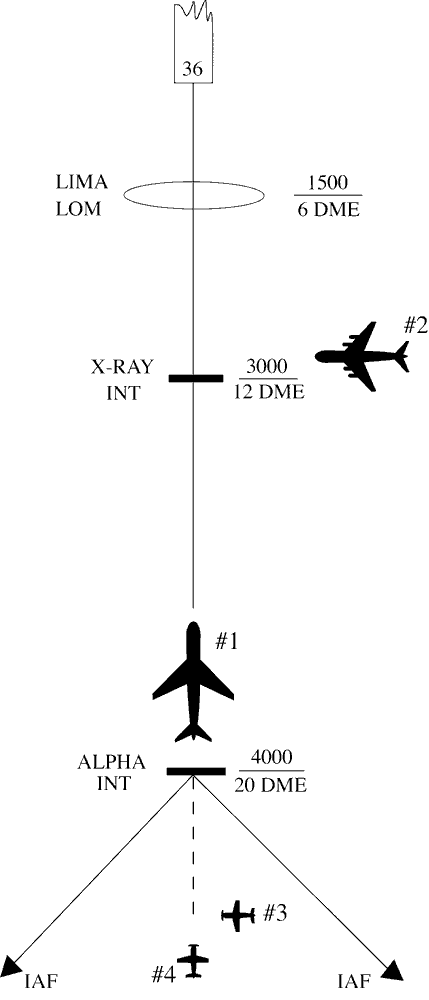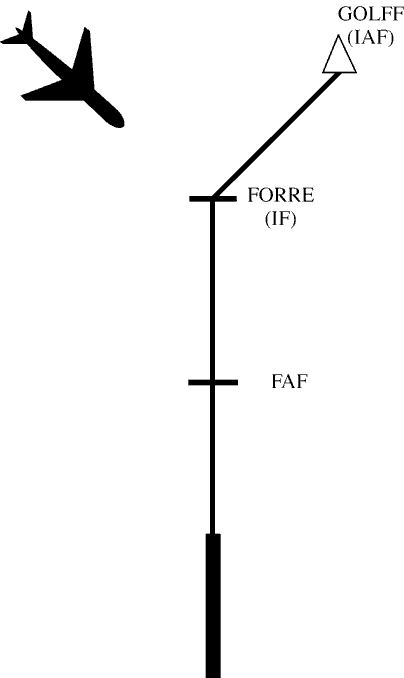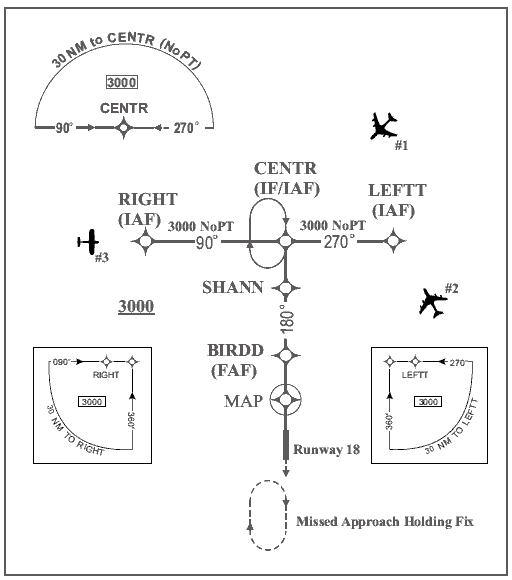5-9-4. ARRIVAL INSTRUCTIONS
- Views Views: 1,498
- Last updated Last updated:
-
5-9-4. ARRIVAL INSTRUCTIONS
Issue all of the following to an aircraft before it reaches the approach gate:
- Position relative to a fix on the final approach course. If none is portrayed on the radar display or if none is prescribed in the procedure, issue position information relative to the navigation aid which provides final approach guidance or relative to the airport.
- Vector to intercept the final approach course if required.
- Approach clearance except when conducting a radar approach. Issue approach clearance only after the aircraft is:
- Established on a segment of a published route or instrument approach procedure, or see FIG 5-9-1 Example 1.
FIG 5-9-1 Arrival Instructions 
- EXAMPLE
- 1. Aircraft 1 was vectored to the final approach course but clearance was withheld. It is now at 4,000 feet and established on a segment of the instrument approach procedure. “Seven miles from X-RAY. Cleared I-L-S runway three six approach.” (See FIG 5-9-1.)
- 2. Aircraft 2 is being vectored to a published segment of the final approach course, 4 miles from LIMA at 2,000 feet. The MVA for this area is 2,000 feet. “Four miles from LIMA. Turn right heading three four zero. Maintain two thousand until established on the localizer. Cleared I-L-S runway three six approach.” (See FIG 5-9-1.)
- 3. Aircraft 3 is being vectored to intercept the final approach course beyond the approach segments, 5 miles from Alpha at 5,000 feet. the MVA for this area is 4,000 feet. “Five miles from Alpha. Turn right heading three three zero. Cross Alpha at or above four thousand. Cleared I-L-S runway three six approach.” (See FIG 5-9-1.)
- 4. Aircraft 4 is established on the final approach course beyond the approach segments, 8 miles from Alpha at 6,000 feet. The MVA for this area is 4,000 feet. “Eight miles from Alpha. Cross Alpha at or above four thousand. Cleared I-L-S runway three six approach.” (See FIG 5-9-1.)
- Assigned an altitude to maintain until the aircraft is established on a segment of a published route or instrument approach procedure.
FIG 5-9-2 Arrival Instructions 
- EXAMPLE
- The aircraft is being vectored to the intermediate fix FORRE for an RNAV approach. “Seven miles from FORRE, cleared direct FORRE, cross FORRE at or above four thousand, cleared RNAV runway one eight approach.”
- NOTE:
- 1. The altitude assigned must assure IFR obstruction clearance from the point at which the approach clearance is issued until established on a segment of a published route or instrument approach procedure.
- 2. If the altitude assignment is VFR-on-top, it is conceivable that the pilot may elect to remain high until arrival over the final approach fix which may require the pilot to circle to descend so as to cross the final approach fix at an altitude that would permit landing.
- 3. Aircraft being vectored to the intermediate fix in FIG 5-9-2 must meet all the provisions described in subpara 4-8-1h2.
- Established on a segment of a published route or instrument approach procedure, or see FIG 5-9-1 Example 1.
- Instructions to do one of the following:
NOTE: The principal purpose of this paragraph is to ensure that frequency changes are made prior to passing the final approach fix. However, at times it will be desirable to retain an aircraft on the approach control frequency to provide a single-frequency approach or other radar services. When this occurs, it will be necessary to relay tower clearances or instructions to preclude changing frequencies prior to landing or approach termination.
- Monitor local control frequency, reporting to the tower when over the approach fix.
- Contact the tower on local control frequency.
- Contact the final controller on the appropriate frequency if radar service will be provided on final on a different frequency.
- When radar is used to establish the final approach fix, inform the pilot that after being advised that he/she is over the fix he/she is to contact the tower on local control frequency.
- EXAMPLE
- “Three miles from final approach fix. Turn left heading zero one zero. Maintain two thousand until established on the localizer. Cleared I-L-S runway three six approach. I will advise when over the fix.”
- “Over final approach fix. Contact tower one one eight point one.”
NOTE: ARSR may be used for establishment of initial approach and intermediate approach fixes only. ASR must be used to establish the final approach fix.
- Where a Terminal Arrival Area (TAA) has been established to support RNAV approaches, inform the aircraft of its position relative to the appropriate IAF and issue the approach clearance. (See FIG 5-9-3.)
- EXAMPLE
- 1. Aircraft 1: The aircraft is in the straight in area of the TAA. “Seven miles from CENTR, Cleared R-NAV Runway One Eight Approach.”
- 2. Aircraft 2: The aircraft is in the left base area of the TAA. “One five miles from LEFTT, Cleared R-NAV Runway One Eight Approach.”
- 3. Aircraft 3: The aircraft is in the right base area of the TAA. “Four miles from RIGHT, Cleared R-NAV Runway One Eight Approach.”
FIG 5-9-3 Basic “T” Design 